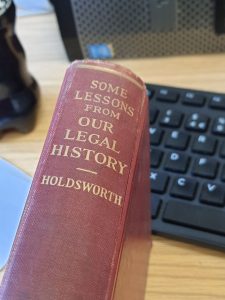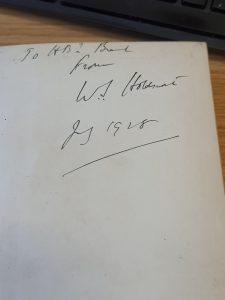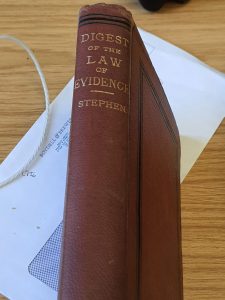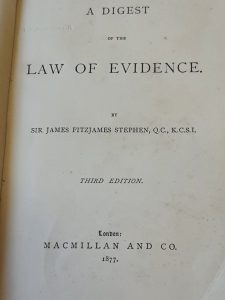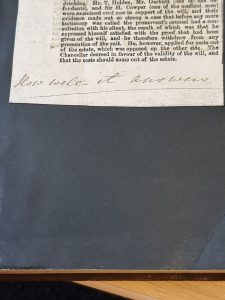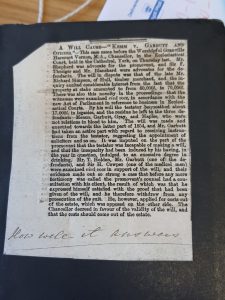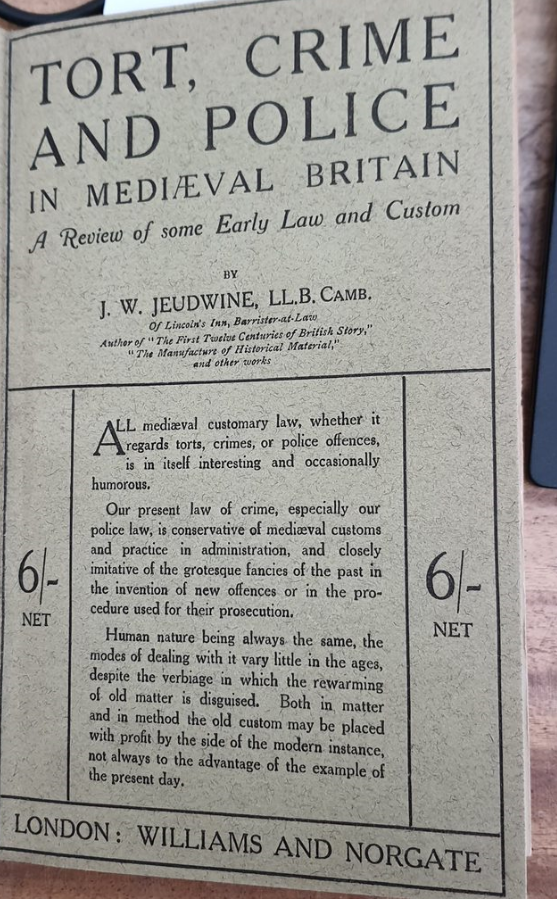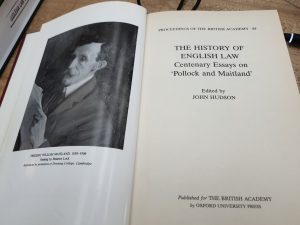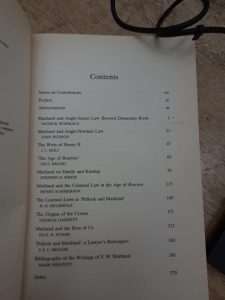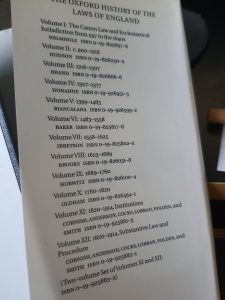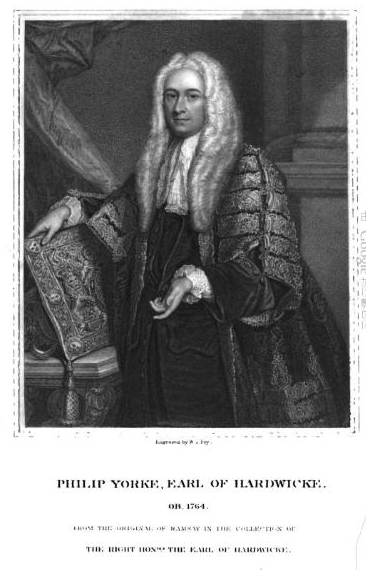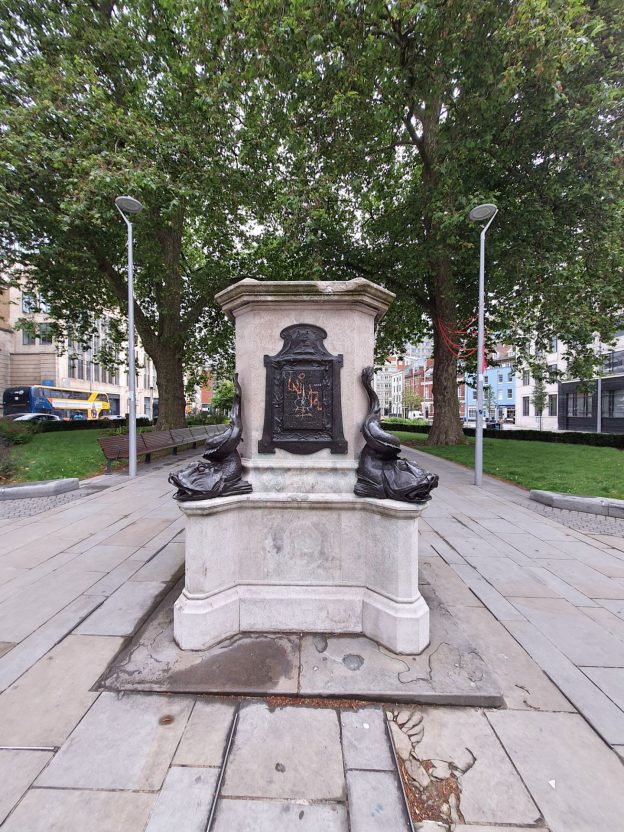A bit out of date, surely, referring to a Euro-dance classic by 2Unlimited? Yes, but … that’s sort of the point of this particular ‘blog as therapy’ post.
Sorting out some long-overdue personal and work admin matters, I came across an email exchange from 2013 (yes I am a digital hoarder/archivally oriented/keeper of proof) about a volume on Limitation of Actions which a former colleague was putting together. I was to write ‘the historical bit’ and various other thrilling chapters would follow. Of course I did my section. Then, for whatever reason, the project ground to a halt.
It is not the greatest piece of legal scholarship, by any means, and it didn’t take me that long, but still … it is a shame to have bothered and never to have seen the thing come out. I have had such varied experiences with edited collections – nothing but good to say about some of them (esp. Weikert/Bennet Hostages Book – that was extremely efficient) but others … I actually have another, more substantial thing for an edited collection which has a number of years of ‘forthcomingness’ behind it, which I hope is actually going to appear very soon … otherwise this may become a series of ‘things I was asked to do, and did, which somehow never got published’ …
The limitation thing, though – I think it’s time to put it out there, for what it is worth, and (shudder) move the email exchange from the ‘to do’ folder to the outer reaches of the ‘archive’ folder. There comes a point when hope and dutiful waiting reach their limitation period, after all.
So here we are, for anyone who wants a quick introduction to the ideas behind limitation of (civil) actions – and bear in mind it is from 2013!
GS
20/8/2021
Gwen Seabourne, Historical Introduction to Limitation of Actions
I: Antiquity and rationale of the limitation idea
The idea of setting some temporal limit to the right to bring a legal action is very ancient, with antecedents in both Old Testament law and Roman law.[1] It is a concept long established in English law and exported to the common law world.
Various reasons have been put forward for having a limit to the right to bring an action. Some of these focus on the claimant, expressing a reluctance to support a person who ‘sleeps on his rights’, [2] or a suspicion that such a claimant may be a perjurer.[3] Others focus on the defendant, and the perceived unfairness of leaving people vulnerable to legal action without temporal limit.[4] A third explanation concerns the legal process itself, the fairness of which might be compromised by allowing ‘old claims’, since evidence may deteriorate or disappear, and memories may become unreliable. Fourthly, there are wider justifications based on claims that not limiting actions would be deleterious to the economy (by discouraging enterprise) or to public order.[5] Finally, specifically in the context of land actions, it has been suggested that, if a claimant brings an action long after a defendant’s alleged wrong, it should be presumed that at some point during this long period of delay, the defendant in fact did gain proper title to the land in question.[6]
II: The English Context
(i) to 1540
English law has had two differing ways of meeting the concerns noted above. One has been to limit actions when the individual claimant’s delay is seen as unconscionable. The central example of this is the equitable doctrine of laches, though some forms of estoppel could also be seen in this way. The other response has been to provide that, in all cases of a particular type, actions shall be barred after a certain period, without the necessity of referring to individual conscience or circumstances.
From the twelfth century onwards, there was royal intervention, setting limitation dates in relation to certain types of legal actions.[7] The strategy was to use as a cut-off point some significant and well-known political event, such as the death or accession of a king, or the return of a king from an overseas expedition.[8] There was a lack of articulation of the reasons for limiting actions in such a way, and it is likely that the concern was with establishing stability of land-holding after a period of uncertainty as much as with fairness to the parties in individual cases. After the the reign of Edward I, the twelfth and thirteenth century dates were not further adjusted, so that the effective limitation period for those actions covered by earlier statutes grew in length each year. Blackstone called this situation ‘absurd’.[9]
As well as the statutes, the medieval common law set temporal limitations in other ways. The related idea of prescriptive acquisition had some role in relation to the acquisition of franchise rights, common rights and perhaps personal freedom.[10] Human lifespan was sometimes a limiting factor, since some forms of action did not survive the parties.[11] For evidential reasons, some criminal cases were required to be brought within a short time limit – notably rape accusations.[12] In addition, within the legal profession, there are hints of a general principle of limitation in the view that ‘every writ has its limitation period’, given in a case of 1285.[13]
(ii) from 1540: ‘another and more direct course which might endure for ever’[14]
The policy of setting by statute a fixed number of years as a limitation period for (some) actions was first introduced in 1540.[15] This legislation of Henry VIII was concerned with land actions.[16]
The statutes’ coverage was relatively narrow. The medieval legislation and the act of 1540 concerned only land actions,[17] and, even within the category of land actions, they were not comprehensive.[18] It was not until the 1623 act that the first limitation periods were set for tort actions,[19] and, for example, contractual suits in which there was a sealed deed were excluded. No general limitation was placed on the bringing of criminal proceedings.[20]
The thirty to sixty year periods fixed in 1540 appear comparatively long, but were a considerable reduction from the effective limitation period in the years immediately preceding the act.[21] Adjustments were made in an act of 1623-4,[22] revising some periods downwards, beginning a trend which has continued into modern times.
It was clear from the start that fixed limitation periods would be a problem for those labouring under some disability in person or at law, and efforts were made to minimise unfair disadvantage in such cases. The statutes therefore included provisions allowing extra time for those in such a position: initially covering those under the age of majority, married women, those in prison or outside England, and in 1623 extended to cover those who were non compos mentis.[23] Other matters of detail and interpretation were worked out in supplementary statutes or in common law cases,[24] and the Chancery and ecclesiastical courts elaborated their own parallel doctrines in the limitation area.[25]
III: More recent history
From the nineteenth century to the present, both statute and case law made adjustments to the law on limitation.[26] The related laches principle continued to develop in the nineteenth century court of Chancery,[27] and, since the merger of common law and equitable jurisdictions in 1873-5, became available in all courts.[28]
The Chancery had long taken notice of the statutory limitation regime – applying limitation periods in connection with actions against trustees, by analogy with statutory provisions.[29] The subject of limitation began to attract treatise writers in the nineteenth century, examining statutes and case law, and sometimes comparing the situation in other jurisdictions.[30]
The trends in statutory limitation have been towards simplification (reduction of numbers of categories – in line with the common law’s general move away from the dominance of forms of action); increase in the scope of the limitation rules,[31] reduction of the length of the limitation period and some erosion of the principle that time does not run against the crown.[32] England and Wales, unlike some other legal systems, have not embraced general principles of limitation with relation to criminal prosecutions.[33]
The matter has not often formed part of undergraduate law studies, with the exception of consideration of adverse possession and limitation in the context of land. It has, however, remained a crucial topic for practitioners and litigants, and has been considered by bodies dedicated to reform and rationalisation of the law on a number of occasions, from the 1820s onwards.[34]
IV: Conclusion
Limitation of actions, then, is an ancient idea. The history of limitation in England and Wales shows a range of different justifications for it and a range of techniques for achieving what is regarded as a fair limitation period in different types of case. It is clear that ideas of appropriate temporal limitation of actions – and which actions should be so limited, and who should and should not be subject to such limitations – has varied considerably over time, and no doubt the rules will continue to evolve with economic and political conditions.
[1] See, e.g., P. du Plessis, Borkowski’s Textbook on Roman Law 4 ed, 76-7, 167; Dig. 41.3.1; A.M. Prichard, ‘Early usucapio’ (1974) 90 LQR 234-45; R.W. Lee, The Elements of Roman Law 4 ed 1956, 125.
[2] YB Trin. 34 Hen. VI, pl. 27; Bl. Comm. bk III c. 10. A’Court v Cross [1825] 3 Bing. 329 at pp. 332, 333; Board of Trade v Cayset, Irvine & Co. Ltd [1927] AC 610 at p. 628; Thomson v Eastwood (1877) 2 App Cas 215, 248; Mountstephen v Brooke 3 B & Ald. 147 106 ER 614; Cholmondeley v Clinton (1920) 2 Jac & W 1, affirmed 4 Bligh 1, 130 ER 540; Doe d Duroure v Jones (1791) 4 TR 300, 308; 100 ER 1031.
[3] See. e.g., H.J. Stephen et al., Mr Serjeant Stephen’s New Commentaries on the Laws of England, , 14th ed., 1903), 541.
[4] Law Commission Consultation Paper no. 151, 1.27; Thomson v Eastwood (1877) 2 App Cas 215, 248-9.
[5] See. e.g., Cholmonderlet v Clinton (1820) 2 Jac & W 139, 37 ER 527, 577; H.J. Stephen et al., Mr Serjeant Stephen’s New Commentaries on the Laws of England, , 14th ed., 1903), 541. Note also contrary views, condemning the idea of limitation of actions, Reeves v Butcher [1891] 2 QB 509. but that, while there are certainly live debates about the detail of limitation periods and their application, the idea that there should be limitation to at least some legal actions is entrenched in the law of England and Wales.
[6] W. Blackstone, Commentaries on the Laws of England (Oxford, 1765-9) four volumes, vol. II, book III, ch 10 p.189; Thomson v Eastwood (1877) 2 App Cas 215, 248 per Lord Hatherley; Mountstephen v Brooke 3 B & Ald. 147 106 ER 614, per Abbott CJ.
[7] P & M II, 51, 81. See, e.g.; the statute of Merton cc.8, 9, statute of Westminster I c. 39 in Statutes of the Realm I, pp. 3, 36. Note that, even before intervention by statute, certain land actions required that action should not be delayed too long. In particular, the action of novel disseisin implied that the claimant had been dispossessed ‘recently’. P & M II, p. 51; Glanvill xiii, 32, 33. Co. 1 Inst. 153.
[8] The practice of dating by association with other events made sense in a less reliably documented world, and was a characteristic practice in medieval law, also seen, for example, in assessments of the age of minor heirs in inquisitions post mortem.
[9] W. Blackstone, Commentaries on the Laws of England (Oxford, 1765-9) four volumes, vol. II, book III, ch 10 p.189. Note however, that the popularity of novel disseisin, which Blackstone was discussing, was in decline from the later medieval period, (see, e.g., W.S. Holdsworth, History of English Law IV, 484) and that limitation statutes did not cover many other important common law forms of action. The position may, therefore, have been somewhat less ‘absurd’ than he thought.
[10] See, e.g., J.H. Baker, Introduction to English Legal History 4th edn (London, 2002), 470-1; P & M 1 p. 425; YB 6 Edw. II Quo Warranto pl. 5 and pl. 6.
[11] See, on debt and trespass, Baker, Introduction, 326, 345, 401. S.F.C. Milsom 77 LQR at 264; Martell’s Case (1382) YB M 6 Ric II pl 33, per Belknap CJ; and on actions for seisin of land when the defendant died and was succeeded by an heir: Littleton’s Tenures, 421 ff.
[12] See, e.g., G.D.G. Hall (ed.), The Treatise on the Laws and Customs of England commonly called Glanvill, book 1, c.6; statute of Westminster I (1275) c. 13.
[13] Prior of Launde’s case (1285), P.A. Brand, The Earliest English Law Reports vol. II (London, 1996), 205-9.
[14] Bl. Comm. vol. II, book III, ch 10, p.189.
[15] 32 H VIII, c. 2 (1540); Statutes of the Realm III, 747. There had been an attempt at something similar in 1529, though this was part of a set of proposals which failed due to parliamentary opposition: W.S. Holdsworth, History of English Law vol. IV 451, 484, 572-4. Note that the statutes’ strategy was to bar the action, rather than the right: Bevil’s Case (1573) Co. Rep. at ff. 11b, 12a. Wainford v Barker (1698) 1 Ld Raym 232.
[16] Its promulgation at that time is likely to have been connected to the upheaval and uncertainty caused by the 1535-40 attempts by Henry VIII to enforce royal claims to feudal revenue by rendering wills of land held to uses (on trust) first totally and then partially invalid. Baker, Oxford History of the Laws of England vol. VI, p. 725 notes that some lawyers were expressing views that this was something which should be reformed.
[17] The early concentration on land actions can be explained, first, by the common law’s particular concern with land law, and, secondly, by the room for genuine doubt as to title to land in a system with surprisingly few formalities for acquisition. In this context, refusing to go too far back into the history of the tenure of a particular piece of land meant that there was a reasonable chance of producing oral testimony if documentary evidence were absent or unsatisfactory.
[18] The statute did not, for example, apply to advowsons and wardships: st. 1 Mar. (1553) session 2 c.5. It did not apply to writs of formedon nor actions involving rights of entry: Holdsworth, History of English Law, 484; 1623 act s.1.It did not apply to the king – only in c.2 of the Jacobean statute was the royal right included, and then a period of sixty years was deemed appropriate.
[19] Significant areas were still not covered by the limitation legislation: see Civil Procedure Act 1833.
[20] This was, in part, explained by the maxim nullum tempus occurrit regi (Co Litt 90b: no time runs against the king), though, given the ‘private’ nature of many prosecutions, this is not a full explanation. There were, however, limitations on some prosecutions from the Tudor period: Holdsworth, History of English Law IV, 499, 525; st.7 Henry 8 c.3, st. 31 Eliz c 5. In addition, many early modern statutes, particularly those dealing with (private) criminal prosecutions, included a specific limitation period.
[21] 32 H VIII, c. 2 (1540); J.H. Baker, Oxford History of the Laws of England vol. VI, p. 725
[22] 21 Jac. 1 c. 16 (1624); Statutes of the Realm IV, 1222; W. Ballantine, A Treatise on the statute of Limitations (21 Jac. I c. 16., (1810)
[23] Section 2 of the 1623 act added those who were non compos mentis to the list of those regarded as having disabilities. Ideas about persons and disability have evolved and other circumstances have had to be taken into account – see, e.g., Limitation (Enemies and War Prisoners) Act 1945.
[24] See, e.g. Anon (1552) Brooke Abr., s.v. ‘Limitations’ pl 2; Prideaux v Webber (1661) 1 Lev. 3; Hyleing v Hastings (1699) 1 Ld Raym 389.
[25] See, e.g. R.H. Helmholz (ed.),Three Civilian Notebooks 1580-1640, Selden Society vol. 27 (2010)., 64, 95, 101, 108; R.H. Helmholz, Oxford History of the Laws of England vol. I, 570, 584-5; W.H. Bryson (ed.), Cases Concerning Equity and the Courts of Equity 1550-1660 vol 2, Selden Society 118 (2001), no. 207, Randall v Tyrney (1612); D.E.C. Yale (ed.), Nottingham’s Chancery Cases (1954, 1961-2) Selden Society 73 and 79, xcv, 448, xcvii, 505; Holdsworth, History of English Law V, 329 Blackwell v Simpson (1582-3) Choyce cases 163; Clench v Tomley (1603) Cary 23; Porter v Pretty (1604) 1 Choyce cases 105-6; Sedgwick v Evan (1582-3 Choyce Cases 167] Sibson v Fletcher (1632-3) 1 Ch Rep 59, 60; Hales v Hales (1636-7) ibid. 105. Garford v Humble (1628) Tothill 26; Moyle v Lord Roberts (1629-30) Nels. 9, 10;.Smith v Clay (1767) 3 Bro CC 639; Pickering v Lord Stambrod (1793) 2 Ves 272 at 280.
[26] See, in particular: Civil Procedure Act 1833, Real Property Limitation Acts 1833 and 1874, Limitation Act 1939, Law Reform (Limitation of Actions) Act 1954, Law Reform Miscellaneous Provisions Act 1971, Limitation Act 1975, Limitation Act 1980. Courts of Chancery worked out the applicability of statutes of limitation in their jurisdiction – see, e.g., Foley v Hill (1844) 1 Phil 399.
[27] Holdsworth, History of English Law V, 329. See also, e.g., Cox v Morgan (1801) 2 Bos and P 368 at 412; Marquis of Cholmondeley v Lord Clinton (1820) 2 Jac & W 1 at 140; Rochdale Canal Co v King (1851) 2 Sim NS 78 at 89; Penny v Allen (1857) 7 De GM & G 409 at 426; Archbold v Scully (1861) 9 HL Cases 360 at 383; Lindsay Petroleum Oil Co v Hurd (1874) LR 5 PC 221 at 239; Re Baker, Collins v Rhodes, Re Seaman, Rhodes v Wish (1881) 20 ChD 230, CA; Re Maddever, Three Towns Banking Co v Maddever (1884) 27 ChD 523, CA.
[28] Judicature Acts 1873-5, 36 & 37 Vict. c. 66 and 38 and 39 Vict. c. 77; Holdsworth, History of English Law XVI, 165; J.E. Martin (ed.), Hanbury and Martin Modern Equity 19th edn 2012, p. 717, Knox v Gye (1872) 5 App Cas 656 at 674; Lindsay Petroleum Co v Hurd (1874) LR 5 PC 221 at 239-41 Re Sharpe [1892] 1 Ch 154 at 168; Weld v Petre [1929] 1 Ch 33 at 51, 52; Re Pauling’s ST [1964] Ch 154 at 168; Alec Lobb (Garages) Ltd v Total Oil GB Ltd [1985] 1 WLR 173.. Laches retained under Limitation Act 1980 s36(2).
[29] Knox v Gye (1872) 5 App Cas 656 at 674. Claims against express trustees became subject to statutory limitation in 1833 (Real Property Limitation Act 1833 s. 25) and those against trustees under implied or constructive trusts became subject to limitation in the Trustee Act 1888.
[30] See, in particular, J.J. Wilkinson, A Treatise on the Limitation of Actions as affecting Mercantile and other Contracts (London, 1829); W, Blanshard, A Treatise on the Law of Limitation (London, 1833), G.B. Mansel, A Treatise on the Law of Limitation (London, 1839), H.T. Banning, A Concise Treatise on the Statute Law of the Limitation of Actions (London, 1877); L.M. Lightwood, The Time Limit on Actions (London, 1909).
[31] For example in the field of debts backed up by a bond or ‘specialty’ was given a limitation period in the Civil Procedure Act 1833.
[32] See, e.g. G. Sharp, A Short tract concerning the doctrine of nullum tempus occurit regi (London, 1779). Nullum Tempus Act, 9 Geo. III c. 16 s 1.J. Chitty, A Treatise on the Law of the Prerogatives of the Crown (London, 1820), 379-80, Holdsworth, History of English Law X, 355
[33] See Note,‘ The statute of limitations in criminal law: a penetrable barrier to prosecution’, University of Pennsylvania Law Review 102 (1954) 630-54; Archbold 2013 ed 1-270; 4-74.
[34] Real Property Commissioners, First Report, Parliamentary Papers vol. X(1829); Law Revision Committee, Fifth Interim Report (Statutes of Limitation) (1936); Law Reform Committee Twenty First Report (Final Report on Limitation of Actions) 1977) Cmnd 6923; Law Commission Consultation Paper no. 151, Limitation of Actions (1998); Law Com. no 270, Limitation of Actions (not taken forward by the government); N.H. Andrews, ‘Reform of the limitation of actions: the quest for sound policy’, CLJ 57 (1998) 589-610. Note the interesting suggestions concerning moving away from an ‘all or nothing’ to an ‘incremental’ approach to limitation which is described in A.J. Wistrich, ‘Procrastination, deadlines and statutes of limitation’ William and Mary Law Review 50 (2008) 607.
Image: a fence – sort of limit, innit? Photo by Markus Spiske on Unsplash
